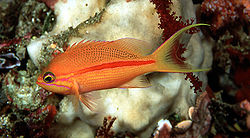Difference between revisions of "Category:Anthias"
From The Aquarium Wiki
| Line 2: | Line 2: | ||
{{Putincategory}} | {{Putincategory}} | ||
[[Image:Pseudanthias fasciatus3838.jpg|right|thumb|250px|''[[Pseudanthias fasciatus]]'']] | [[Image:Pseudanthias fasciatus3838.jpg|right|thumb|250px|''[[Pseudanthias fasciatus]]'']] | ||
| − | + | Anthias belong to the large family '''[[Serranidae]]''', subfamily '''Anthiinae'''. Anthias are mostly small, peaceful, and very colourful; and are thus quite popular within the ornamental fish trade. They are best in social groups in very large tanks, a few more females than males. | |
Anthias are protogynous hermaphrodites. All Anthias are born female; if a dominant male perishes, the largest female of the group will often change into a male to take its place. | Anthias are protogynous hermaphrodites. All Anthias are born female; if a dominant male perishes, the largest female of the group will often change into a male to take its place. | ||
Latest revision as of 01:31, 3 January 2018
Error creating thumbnail: Unable to save thumbnail to destination
Please copy and paste ' [[Category:Anthias]] ' into the end of your article to include it in this category.
| Contents | Top · 0-9 · A B C D E F G H I J K L M N O P Q R S T U V W X Y Z |
|---|
Anthias belong to the large family Serranidae, subfamily Anthiinae. Anthias are mostly small, peaceful, and very colourful; and are thus quite popular within the ornamental fish trade. They are best in social groups in very large tanks, a few more females than males.
Anthias are protogynous hermaphrodites. All Anthias are born female; if a dominant male perishes, the largest female of the group will often change into a male to take its place.
Pages in category "Anthias"
The following 37 pages are in this category, out of 37 total.
P
S
Media in category "Anthias"
The following 11 files are in this category, out of 11 total.
- Squarespotanthia-5164.jpg 589 KB
- Squarespotanthia.jpg 30 KB











